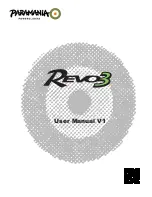
2) Ball bearing wing hinge assembly:
The hinge bearing plates are installed on the fuselage with the bearings already installed in
them.
The wing spars are attached simply by slipping them between bearing plates on each side and
screwing in the supplied #5-40 X 3/4" socket head cap screws. Screw the cap screws in from
the front of the bird and apply BLUE Loctite to screw at the center hole at the end of the
aluminum spar ferrule and screw the bolt in and out slightly to disperse the Loc-tite. This is
done to avoid getting Loc-tite in the ball bearings which may damage them. Tighten the cap
screws down tightly against the front of the bearing plates. Tighten down gently and the
check and make sure there is no binding. The spars should move freely at the hinge. Let the
Loc-tite set up once adjusted.
3) Fasten the wingsail
Now notice there are 3 slots in the center Dacron strip running down the center of the wingsail.
Slip these slots down over the corresponding posts on the top of the fuselage.
The wingsail is held in place with small included O-rings ( in the main parts bag) which snap
down onto the fuselage posts.
Once you have the wingsail slipped onto the posts, now snap the diagonal batten ball link
housings onto the metal balls at the rear root of the fuselage. Check that the wing can freely
pivot up and down.
Now get the loc-tite ready
Shake the loc-tite well and apply a drop or two to the threaded aluminum spar ferrule holes
and attach the large ball link connecting rods with the cap screws provided. Depending
on the date of manufacture, your kit may have #4-40 cap screws, or 3mm cap screws.
Whichever it has, the threaded ferrules holes will match the screws.
Now back out the screws mounting the bottom of the connecting rods to the crankshaft,
apply loc-tite and re-tighten. Tighten all four screws tightly but within reason to avoid stripping
the threads. Allow the loc-tite to set up ( an hour or so).
This completes the wing assembly
______________________________________________________________________
12) Battery Charging and Precautions:
The new lithium polymer batteries offer even better power to weight and duration than NIMH
batteries. Li-poly's are the latest trend in electric R/C and will probably replace NIMH batteries
in R/C applications altogether in the near future.
Lithium batteries are extremely light for their energy output and storage. They do not have the
self discharge trait of NIMH batteries, not do they require cycling, however they are affected by
cold temperatures. Performance may suffer greatly as a result in temperatures below 50
degrees F.




































